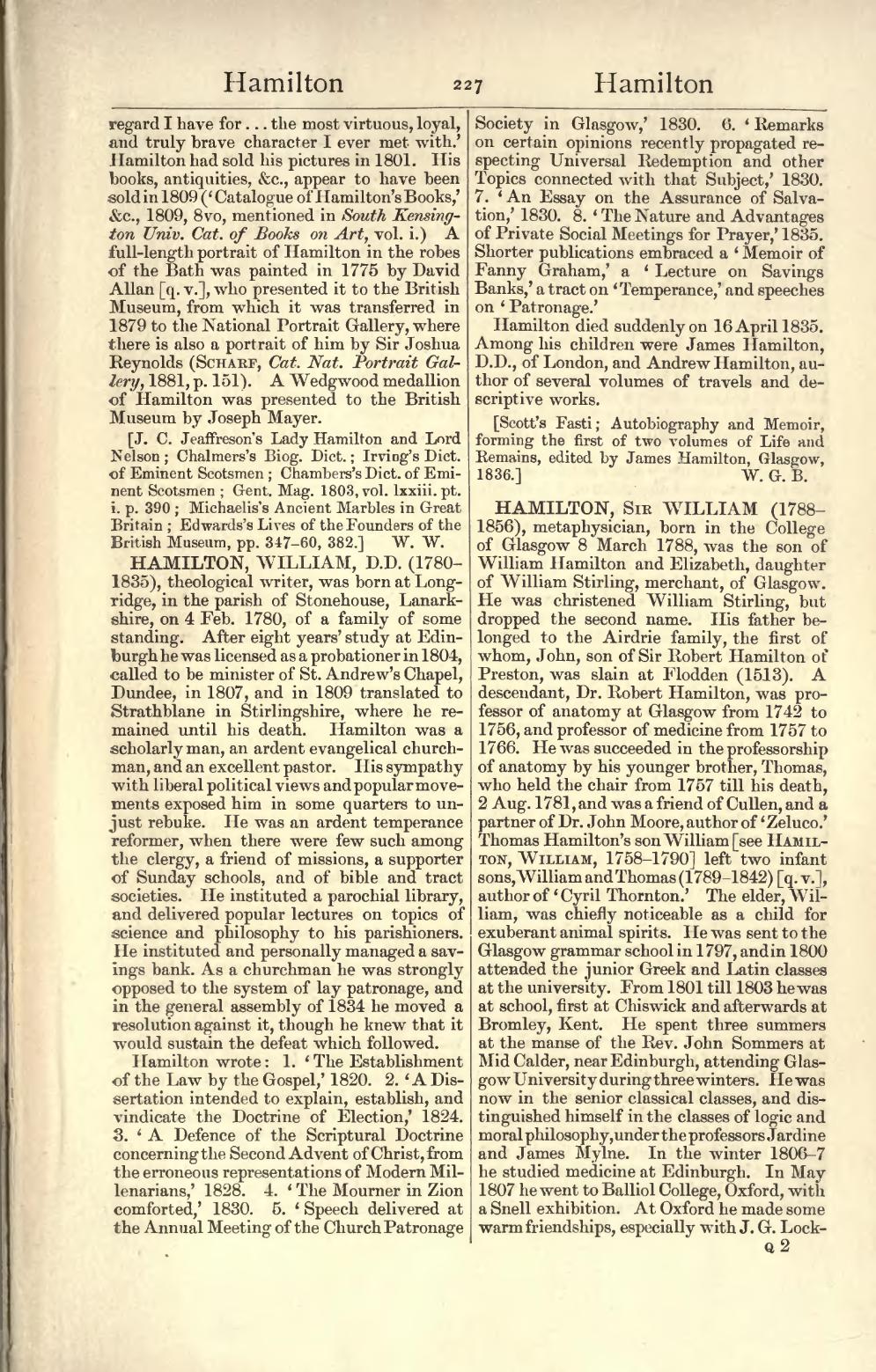regard I have for ... the most virtuous, loyal, and truly brave character I ever met with.' Hamilton had sold his pictures in 1801. His books, antiquities, &c., appear to have been sold in 1809 ('Catalogue of Hamilton's Books,' &c., 1809, 8vo, mentioned in South Kensington Univ. Cat. of Books on Art, vol. i.). A full-length portrait of Hamilton in the robes of the Bath was painted in 1775 by David Allan Allan, David [q. v.], who presented it to the British Museum, from which it was transferred in 1879 to the National Portrait Gallery, where there is also a portrait of him by Sir Joshua Reynolds (Scharf, Cat. Nat. Portrait Gallery, 1881, p. 151). A Wedgwood medallion of Hamilton was presented to the British Museum by Joseph Mayer.
[J. C. Jeaffreson's Lady Hamilton and Lord Nelson; Chalmers's Biog. Dict.; Irving's Dict. of Eminent Scotsmen; Chambers's Dict. of Eminent Scotsmen; Gent. Mag. 1803, vol. lxxiii. pt. i. p. 390; Michaelis's Ancient Marbles in Great Britain; Edwards's Lives of the Founders of the British Museum, pp. 347–60, 382.]
HAMILTON, WILLIAM, D.D. (1780–1835), theological writer, was born at Longridge, in the parish of Stonehouse, Lanarkshire, on 4 Feb. 1780, of a family of some standing. After eight years' study at Edinburgh he was licensed as a probationer in 1804, called to be minister of St. Andrew's Chapel, Dundee, in 1807, and in 1809 translated to Strathblane in Stirlingshire, where he remained until his death. Hamilton was a scholarly man, an ardent evangelical churchman, and an excellent pastor. His sympathy with liberal political views and popular movements exposed him in some quarters to unjust rebuke. He was an ardent temperance reformer, when there were few such among the clergy, a friend of missions, a supporter of Sunday schools, and of bible and tract societies. He instituted a parochial library, and delivered popular lectures on topics of science and philosophy to his parishioners. He instituted and personally managed a savings bank. As a churchman he was strongly opposed to the system of lay patronage, and in the general assembly of 1834 he moved a resolution against it, though he knew that it would sustain the defeat which followed. Hamilton wrote:
- 'The Establishment of the Law by the Gospel,' 1820.
- 'A Dissertation intended to explain, establish, and vindicate the Doctrine of Election,' 1824.
- 'A Defence of the Scriptural Doctrine concerning the Second Advent of Christ, from the erroneous representations of Modern Millenarians,' 1828.
- 'The Mourner in Zion comforted,' 1830.
- 'Speech delivered at the Annual Meeting of the Church Patronage Society in Glasgow,' 1830.
- 'Remarks on certain opinions recently propagated respecting Universal Redemption and other Topics connected with that Subject,' 1830.
- 'An Essay on the Assurance of Salvation,' 1830.
- 'The Nature and Advantages of Private Social Meetings for Prayer,' 1835.
Shorter publications embraced a 'Memoir of Fanny Graham,' a 'Lecture on Savings Banks,' a tract on 'Temperance,' and speeches on 'Patronage.' Hamilton died suddenly on 16 April 1835. Among his children were James Hamilton, D.D., of London, and Andrew Hamilton, author of several volumes of travels and descriptive works.
[Scott's Fasti; Autobiography and Memoir, forming the first of two volumes of Life and Remains, edited by James Hamilton, Glasgow, 1836.
HAMILTON, Sir WILLIAM (1788–1856), metaphysician, born in the College of Glasgow 8 March 1788, was the son of William Hamilton and Elizabeth, daughter of William Stirling, merchant, of Glasgow. He was christened William Stirling, but dropped the second name. His father belonged to the Airdrie family, the first of whom, John, son of Sir Robert Hamilton of Preston, was slain at Flodden (1513). A descendant, Dr. Robert Hamilton, was professor of anatomy at Glasgow from 1742 to 1756, and professor of medicine from 1757 to 1766. He was succeeded in the professorship of anatomy by his younger brother, Thomas, who held the chair from 1757 till his death, 2 Aug. 1781, and was a friend of Cullen, and a partner of Dr. John Moore, author of 'Zeluco.' Thomas Hamilton's son William [see Hamilton, William, 1758-1790] left two infant sons, William and Thomas (1789-1842) [q. v.], author of 'Cyril Thornton.' The elder, William, was chiefly noticeable as a child for exuberant animal spirits. He was sent to the Glasgow grammar school in 1797, and in 1800 attended the junior Greek and Latin classes at the university. From 1801 till 1803 he was at school, first at Chiswick and afterwards at Bromley, Kent. He spent three summers at the manse of the Rev. John Sommers at Mid Calder, near Edinburgh, attending Glasgow University during three winters. He was now in the senior classical classes, and distinguished himself in the classes of logic and moral philosophy, under the professors Jardine and James Mylne. In the winter 1806-7 he studied medicine at Edinburgh. In May 1807 he went to Balliol College, Oxford, with a Snell exhibition. At Oxford he made some warm friendships, especially with J. G. Lock-
